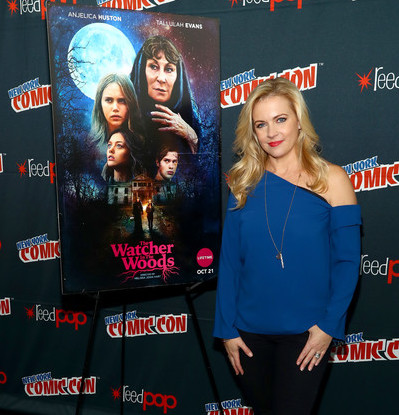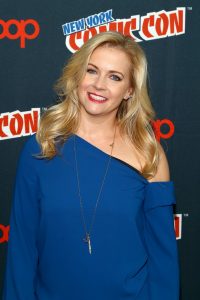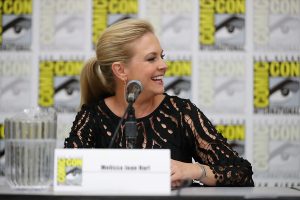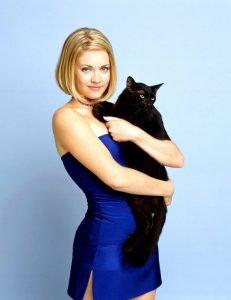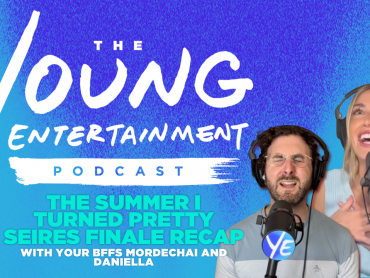Melissa Joan Hart is no stranger to the paranormal. She’s best known for her role as the Sabrina the Teenage Witch, the legendary half-mortal who faces the struggles of growing up…all while discovering her magical powers. You may also know her as the title characters of the hit shows “Clarissa Explains It All” and “Melissa and Joey.” She’s best known for acting, but this time, Melissa Joan Hart is stepping behind the camera and directing a remake of the 1980 thriller “The Watcher in the Woods.” At Comic Con, we sat down with Melissa to talk about her directing style, what it was like to remake her favorite horror movie, and if she would appear in the upcoming CW series about Sabrina The Teenage Witch.
Young Entertainment Magazine: “The Watcher in the Woods” premieres this month on Lifetime. The original aired in 1980—were you a fan of the original?
Melissa Joan Hart: Yes, that’s why we decided to remake it. I watched that movie with my sisters endlessly as a child. It was like a sleepover movie. I think for a lot of people, it was either their first introduction into the horror genre, or they never heard of it. For me, I was obsessed with it. So when we were filming Sabrina [the Teenage Witch] and my mom was producing it, and she said to me ‘What movie do you want to do during your offseason break? What movie do you want to remake?’ and I said Watcher in the Woods. So she tried to get the rights to it for 17 years. And then we were finally able to get them! I was too old to play Jan, but luckily I was on a roll with my directing career and so I was able to direct it.
YEM: You directed before on “Sabrina the Teenage Witch” and “Melissa and Joey.” What motivated you to become a director?
MJH: Well it’s because of “Sabrina the Teenage Witch.” On Sabrina, we had all these well seasoned directors coming in to direct the show, but they were very confused by the special effects and by the cat. We had one of the first hybrid shows on television, so it was a really, really complex show. It took us three days a week to shoot where as it really should have taken us five or six. It really was more like an episodic show than it was a sitcom. So with everybody coming in and being confused by it, we would always boss them around and say ‘No, you have to do it this way,’ and we were just sick of explaining it to people. It just became easier for us to do it in-house and everybody just direct it. “So I’ll do one, you do one, you do the next one,” and we all just started directing the show. I found that it really spoke to me. It was much more creatively fulfilling to me, and it was just really satisfying to read a script and visualize it and make it come alive. And I found it very complicated because you have to make really quick decisions about things that seem minuscule. Just questions like ‘what color should that duffle bag be’ could be a huge question in a movie sometimes. You could have conversations for two days about this duffle bag—and I’ve done that! I’ve had that conversation before that went on for like a week! But you also have to say, where’s the camera going to go? What’s the lighting going to be like? How are we going to color time this? What’s the sound effect going to be like? How are we going to cast it? Where are we going to shoot it? How big do we want this prop? All these tiny, and yet large questions that put this whole story together. You really have to be a storyteller. I love that, but it’s also exhausting so I feel like I can really only handle a few a year because it’s a big job.
YEM: Did being an actress help you enter the directing world?
MJH: I feel like there are two kinds of directors. Probably more than two, but two that I really look at. You have the film school director who knows cameras, angles, lenses, filters, lighting, etc. And then you have an actor’s director, who might be an actor, but also might just work more closely with the actors. You have the ones that are more hands off and let the actors do their thing but know how to help or mold them when they need a little direction push. And then there’s the directors that either over direct and kind of bully actors into playing parts a different way even though you were cast in this part a certain way. When you audition for a part a certain way, you expect that that’s how they want you to play it, but then you get on set and some directors change the premise completely. So it’s not really you that they wanted, maybe it’s just your look and then they want you to play it an entirely different way. So I feel like there are actor’s directors, and then directors that are not actor’s directors. I try very much to be an actor’s director because that’s the world I come from. But just being on sets for 36 years I’ve picked up on the lingo, which could be really complicated for a first time director, even one that comes from film school. You may know the technical name for something, but there are so many things that come with experience. Just having that shorthand with the crew, knowing what a production day should be like, knowing what a call sheet should look like, those sorts of things. So I definitely had the experience. I just then had to… boss around actors… which I never had to do before. And decide what color the duffle bag should be. It’s complicated, but it’s a lot of fun. And when it comes together like this movie, there’s no better feeling. It’s like a little masterpiece.
YEM: There are quite a few young actors in this movie. Did you give the young actors advice on being in the entertainment industry?
MJH: Not advice about the industry. But whether I’m leading a cast or I’m directing, I have to lead by example. Number one for me is whatever my attitude is on set, that’s kind of how it will trickle down to everyone else. I think a lot of actors don’t realize the power they have over the set—or they do and they enjoy it a little too much. But I think it’s a really important example to these younger kids to be like “Let’s be really courteous. Let’s be careful about other people’s time. Let’s not make people wait. Let’s be prepared.” This is a job. We’re going to do our job and we’re all going to do it together. We want the same outcome, we want to make a wonderful movie and then we want to go home to our families and have a regular life. So let’s do the work while we’re here, let’s do the best we can and then go home. I’m not for anyone messing around or anyone that doesn’t come to set on time, anyone that’s not prepared with their lines, that kind of thing. But luckily, all this young talent that I’ve been working with, whether it be Taylor [Spreitler] and Nick [Robinson] on Melissa and Joey, or this amazing young cast of The Watcher in the Woods, they all were so prepared. They came with no attitude, ready to work, and they were already so talented. You hopefully find people that have talent, so if you cast it correctly, they will do the work for you. It’s really just keeping them on story. My job is to keep the story on point—getting from A to Z. If they’re missing a point, I help them get there. You fine-tune it. But with all these actors, they were so talented. They really didn’t need that much guidance. The only thing that I found was with some of the kids, sometimes they lack energy. Teenagers want to be serious, so they act older than their age. A lot of them would be dragging their feet and I’d be like, “Guys—you’re teenagers! Can we act like we’re 16 and we have somewhere to go? Come on!” Just giving them that energy was a big thing. Especially with Tallulah [Evans] who had big scare moments. Instead of having big jumps, sometimes she would just turn. So I would say, “No—it has to be fast!” So I ended up calling it a ‘hair-whip.’ I’d tell her to do a hair whip, and she would do it. That’s something I did to help her out there. Or I gave her a device of like, “play with your necklace when you’re nervous. So every time your character is nervous, you’ll play with your necklace.” So she would do that and it became her thing. Sometimes when she would jump for the scares, I had to warn the crew that I would literally try to scare her. The little one, Dixie [Egerickx], who plays Ellie, she was really nervous about the part where she has to be possessed and her character would scream ‘nerak’ really loud over and over. She was very giggly about it and very nervous. So I cleared the set, and we yelled at each other for a while to get her comfortable. I would yell ‘nerak’ at her and she would yell it back at me. And I’d say, “No, louder! Yell at me!” So I would scream her line, and she would scream it back and then she felt comfortable. Then we brought the crew back in one at a time and when we filmed that scene, I stood right in her eye line so she would be screaming at me like we practiced. And we got it! It looked so cool and so scary like we wanted. Luckily I have little kids so I know how to talk to kids. I wish someone had done that with me when I was a young actress.
YEM: How is this project different from other projects you’ve directed in the past?
MJH: One big difference is that I wasn’t in it. This was the only thing I’ve directed that I haven’t been in. So that was a big help. To be able to be in my jeans, a puffy jacket because we were filming in the woods and I could be really comfortable, and just do the job I had to do. Instead of worrying about ‘when do I have to go back to make-up?’ and ‘what’s my line in the scene I have coming up?’ I really could focus just on the directing. It’s also one of the first thrillers I worked on. There was a show on Disney Channel in the 90s called “So Weird” and I directed one of those. My sister Emily was in it, I kind of always direct her. And then I did a short film called “Mute” that’s on iTunes, with my sister Emily and Emily Deschanel. That was really fun but that was more like a dark comedy or film noir. That was like the first step into this. And now there’s a film that hopefully I’ll be directing next year, that’s like a step up from “The Watcher in the Woods.” So I keep going deeper and deeper into this genre.
YEM: Do you have a favorite horror movie? And a favorite movie directed by a woman?
MJH: This was my favorite horror movie, and I would say it still is. I liked Texas Chainsaw Massacre for a while, and while I was working on this movie, I watched a lot of Hitchcock. As far as one directed by a female, I’m obsessed with The Handmaid’s Tale. Those episodes are mostly directed by women. I’m obsessed with that show and that’s very female oriented.
YEM: Sabrina Spellman is coming back—The CW announced that they are working on a new show revolving around Sabrina the Teenage Witch. If they asked you to be involved in the project, would you be a part of it?
MJH: I mean, yeah! But with everything, it always depends on the creative aspect of it. Who am I? What would I be doing? Is it smart? Is it fun? Is it worth my time and energy leaving my family? But yeah, I think it would be fun to do the nostalgia side of it. I just would want to make sure it’s good. I’ve been asked to do a few things, parodies of Clarissa, parodies of Sabrina. But if it’s not smart, then why bother? People would panic. So it would just have to be something really smart. I only want to leave my family to do projects that are really smart and that I know I’m going to have a good time on. Like if they ask me to direct a sequel to “Watcher”—I’m there. Family, see you later, I’m going to work with this fabulous cast, amazing crew, and have some fun in the woods. I’m at an age now where I’ve worked for a long time. I’ve been working for 36 years. I used to say yes to every project, now I’m like, no. At this point, it has to be something that’s worth my time. I would love to do something local, and then direct, like, two things a year. Have something stable and then have my creative thing. That’s like my new dream now.
“The Watcher in the Woods” premieres October 21st at 8pm EST on Lifetime!
